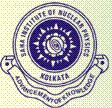(This includes study of molecular structure often related to chemical science, and also fundamental aspects of Positronium (e+e-) reaction)
INTRODUCTION: At SAHA INSTITUTE OF NUCLEAR PHYSICS (SINP) we have had a long tradition of positron research spanning over experiment and theory. To the best of our knowledge, experimentation in positron annihilation spectroscopy at SINP started some time back during the 1960s. However another avenue, 'Psitronium Chemistry'(electron- positron in a bound state designated as the lightest atom, serving as a chemical probe), came in to effect in the late 1980s and triggered activities of chemical phenomenology ranging from liquid systems to various molecular substrates. This paved the way for physicists and chemists to indulge in joint activities both in experiment and theory. These activities have evolved newer interests with time and the results from the laboratory & group have shown up in several dissertations and fruitful publications which are hitherto enlisted.
ROLE OF POSITRON/POSITRONIUM AS A MULTIDIMENSIONAL PROBE : POSITRON( e+), the smallest positive elementary particle of nuclear origin, with all its potency is actually omnipresent and sees through all material architecture on earth. It actually depends on 'the investigators' to decipher the tact of the nature, extract the information and thus rejoice the understanding of the 'Truth'(as far as possible). A short lived bound state of electron and its anti particle positron, form an exotic atom (e+e-), positronium (hence forth referred as Ps) is also an important entity which has been used in the assay of molecular structural aspects in almost all useful spheres of substances. It would be pertinent perhaps to know : how and why is positron /Ps is a viable tool so importantly recognized in physics, chemistry or for biological diagnostic processes. It is the positron-electron annihilation process (mostly two photon annihilation event) each photon emitted with energy mc2 =0.511 Mev, corresponding to the rest mass of the particle. These annihilation photons carry all the information encoded about the site from where it is annihilating in the medium. Hence, positron or Ps annihilation spectroscopy (PAS) has emerged today as the technique, state of the art nano technology ( or may be even sub nano technology), due to the ability of positrons to be associated with a variety of electronic states in molecular media ( e.g , Ps, positron and Ps bound to vacancies and voids and positron-molecule complexes). PAS yield unique information regarding the molecular property under study. The unique aspect of PAS derives from the fact that the annihilation photons contain information on both electron density and the electron momentum which is characteristic of the annihilation site. We are involved in studying all kinds of molecular matter (specially soft matter that encompasses, molecular liquids, weakly bound states of molecular aggregates, macro molecules, supra molecular assembly, porous systems, layered structures, biologically important molecules and also nano structures. WELCOME A glimpse of our Laboratory facilities : (Visit Room No : 356, 358 and 369 in Phase-II Building)
|

